
 |
Register or Log In To remove these advertisements. |
|
|
|
|||||||
 |
|
|
Thread Tools | Display Modes |
|
|
#1 |
|
Registered User
 Join Date: Feb 2009
Location: Redding, Ca
Posts: 333
|
Drive shaft vibration?
I have 700R4 and drive shaft shop shortened drive shaft, 2 piece with new carrier bearing. All should be new and balenced. WHen I accelrate hard, I have vibration that feels like coming from drive shaft or rear end. ANyone else had this?
|
|
|

|
|
|
#2 |
|
Registered User
Join Date: Apr 2009
Location: Dawson, Ga
Posts: 513
|
Re: Drive shaft vibration?
Do some Googling as I have read some things on this subject related to later model engine and trans in earlier model cars, I which one of the forums for LS1 or LT1 engines i found it on but
Try this one out http://www.ls1tech.com/forums/ |
|
|

|
|
|
#3 |
|
Senior Car Nut
 Join Date: Jan 2008
Location: shellman bluff, GA
Posts: 1,411
|
Re: Drive shaft vibration?
Steve, just to clarify, it only does it under hard acceleration, not during normal part-throttle run-up thru the gears or cruising? And, I assume, no problem before the switch to the 700r4/shorter drive shaft? Truck is lowered or no?
__________________
Larry |
|
|

|
|
|
#4 |
|
Registered User
Join Date: Feb 2008
Location: Sidney,b.c.
Posts: 4,425
|
Re: Drive shaft vibration?
could be the centre brg support( even if it is new), perhaps you dropped a needle brg, motor or trans mount
ron |
|
|

|
|
|
#5 |
|
Registered User
 Join Date: Feb 2009
Location: Redding, Ca
Posts: 333
|
Re: Drive shaft vibration?
Larry-Yes, yes and yes-5 inch drop...I suspect you think it might be the shaft is no longer in alignment with rear end?
|
|
|

|
|
|
#6 |
|
Registered User
Join Date: May 2009
Location: Motor City
Posts: 9,245
|
Re: Drive shaft vibration?
When you accelerate hard from a stop, or accelerate after you are rolling?
If it is a "couple of kicks" (three, maybe) when accelerating from a stop then it sounds like typical "Launch Shudder". I did some playing around one time and found it can be related to the length of the front shaft vs length of the rear shaft, with the two shafts being closer in length being best case. If so, then I could imagine shortening the front shaft to create a launch shudder as described. K
__________________
Chevrolet Flint Assembly 1979-1986 GM Full Size Truck Engineering 1986 - 2019 Intro from an Old Assembly Guy: http://67-72chevytrucks.com/vboard/s...d.php?t=342926 My Pontiac story: http://forums.maxperformanceinc.com/...d.php?t=560524 Chevelle intro: http://www.superchevy.com/features/s...hevy-chevelle/ Last edited by Keith Seymore; 05-27-2010 at 10:24 AM. |
|
|

|
|
|
#7 |
|
Senior Car Nut
 Join Date: Jan 2008
Location: shellman bluff, GA
Posts: 1,411
|
Re: Drive shaft vibration?
just trying to isolate the possible cause.
Since the only change is the longer transmission and subsequent shorter front driveshaft (AND, therefore, relocated front u-joint), the shorter front shaft could be causing what Keith describes. for reference, my front driveshaft is 31", the rear is 35". My engine has clam-shell mounts and sits about 2-2.5" ahead of the original location as near as I can tell. if your engine is in the original location, your front driveshaft is going to be that much shorter, which may be causing the aforementioned problem. On the otherhand, the relocated (rearward) u-joint would be accentuating the normal u-joint angle. Also, I assume you modified the tranny mount, if so the relocated mount may have effected this angle by raising or lowering the u-joint location. Just things to consider. Aligning these 2 piece shafts has never been explained well in any of the sources I've read. I'm just surprised more people don't seem to have problems, especially with lowering so popular.
__________________
Larry Last edited by fleetsidelarry; 05-26-2010 at 03:21 PM. Reason: added driveshaft dimensions and engine location info |
|
|

|
|
|
#8 |
|
Registered User
Join Date: Jan 2010
Location: maple ridge BC canada
Posts: 58
|
Re: Drive shaft vibration?
axle wrap??? rear susp. bushing all in good shape??
|
|
|

|
|
|
#9 |
|
Senior Member
 Join Date: Nov 2007
Location: Greenville, SC
Posts: 873
|
Re: Drive shaft vibration?
Check your operating angles. If they are equal the drive shaft forces from each universal cancel each other. If the operating angles are different they do not and give a vibration. The vibration would be worse in proportion to the torque applied. So it might be acceptable for normal acceleration but not for high torque starts.
Here is the definitive source for aligning drive shafts I think. http://www2.dana.com/pdf/J3311-1-HVTSS.PDF Good luck, TR
__________________
1965 C10 SWB Fleet Two owner LS2 Swap Thread http://67-72chevytrucks.com/vboard/s...d.php?t=413880 |
|
|

|
|
|
#10 |
|
Registered User
Join Date: Feb 2008
Location: Sidney,b.c.
Posts: 4,425
|
Re: Drive shaft vibration?
the length of the frt shaft has nothing to do with it. all 3 ujoints should be in the same plane. all of the crosses should be the same. you will have to drop the d/shaft and move all of the joints by hand to seee if one is binding which would be cause by a dropped needle ( the needle is usually jammed between the end of the cross and the cap. the rear cross may not be fully seated in the rear yoke due to a dropped needle. this happens to a lot of people.
ron |
|
|

|
|
|
#11 | |
|
Senior Car Nut
 Join Date: Jan 2008
Location: shellman bluff, GA
Posts: 1,411
|
Re: Drive shaft vibration?
Quote:
__________________
Larry |
|
|
|

|
|
|
#12 |
|
Registered User
Join Date: May 2009
Location: Motor City
Posts: 9,245
|
Re: Drive shaft vibration?
Not true. When I was a driveline engineer for GM Fullsize truck, at the GM Desert Proving Ground, we performed a series of experiments on a GMT400 extended cab. These trucks had an inherent propensity for launch shudder, which resulted in a full scale effort to fix the problem. By equalizing the lengths of the front and rear shafts (ie, increasing the length of the front shaft), keeping the u joint working angles the same as before, I was able to minimize or eliminate the launch shudder in these models. I received a patent for this work. I will agree, however, that for most people, in dealing with production components, what you have said is true. But it is simply not true universally, when throwing off the constraints of having to use the production vehicle architecture. I normally wouldn't have brought it up, except it seemed relevant here since the original poster had shortened his original front shaft (directionally incorrect, according to my earlier experiments). He may have introduced some fundamental lever force imbalances (not rotational forces) that refinement of u joint working angles may not be able to overcome. BTW - I always run a one piece shaft whenever I can get away with it (through increased shaft diameter, premium materials or reduced vehicle speed), just to avoid these types of problems. K
__________________
Chevrolet Flint Assembly 1979-1986 GM Full Size Truck Engineering 1986 - 2019 Intro from an Old Assembly Guy: http://67-72chevytrucks.com/vboard/s...d.php?t=342926 My Pontiac story: http://forums.maxperformanceinc.com/...d.php?t=560524 Chevelle intro: http://www.superchevy.com/features/s...hevy-chevelle/ Last edited by Keith Seymore; 05-27-2010 at 10:26 AM. |
|
|

|
|
|
#13 | |
|
Registered User
Join Date: Feb 2008
Location: Sidney,b.c.
Posts: 4,425
|
Re: Drive shaft vibration?
Quote:
in your exercise you wer using an extended tube to make up the vairiance for an extended cab. how much of an extension. unless one changes the other dimensional qualities of the tubing for the length of the shaft, you could get flex in the shaft it if don't ask, you don't know I used to spec out trucks(IHC & Pacific)in the early -mid 70's from l/duty to off hwy ron |
|
|
|

|
|
|
#14 | |
|
Registered User
Join Date: May 2009
Location: Motor City
Posts: 9,245
|
Re: Drive shaft vibration?
Quote:
As it turns out, the driveline disturbance was forcing a transfercase tailshaft vertical motion. The driving function (rotational) was exciting a vertical (ie, not rotational) sensitivity in the truck. My only - only - point (and as I say, I normally wouldn't have brought it up) was that once you start messing with the base vehicle architecture then sometimes the old rules no longer apply.... I normally try to stay out of these discussions, because they are so hard to diagnose and repair via remote control (and because they can sometimes get kind of "emotional"). K
__________________
Chevrolet Flint Assembly 1979-1986 GM Full Size Truck Engineering 1986 - 2019 Intro from an Old Assembly Guy: http://67-72chevytrucks.com/vboard/s...d.php?t=342926 My Pontiac story: http://forums.maxperformanceinc.com/...d.php?t=560524 Chevelle intro: http://www.superchevy.com/features/s...hevy-chevelle/ Last edited by Keith Seymore; 05-27-2010 at 11:28 AM. |
|
|
|

|
|
|
#15 |
|
Registered User
Join Date: May 2009
Location: Motor City
Posts: 9,245
|
Re: Drive shaft vibration?
Also, amazingly I was able to find my old paper on the subject (I kept some of the better ones
 ). ).As a sidebar, and just for fun, I'll post it here for anyone who might be interested: 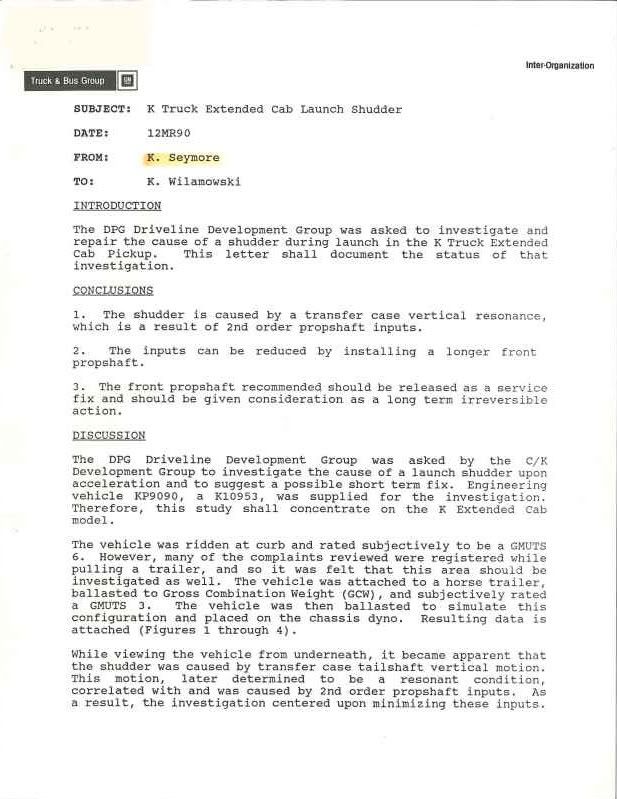 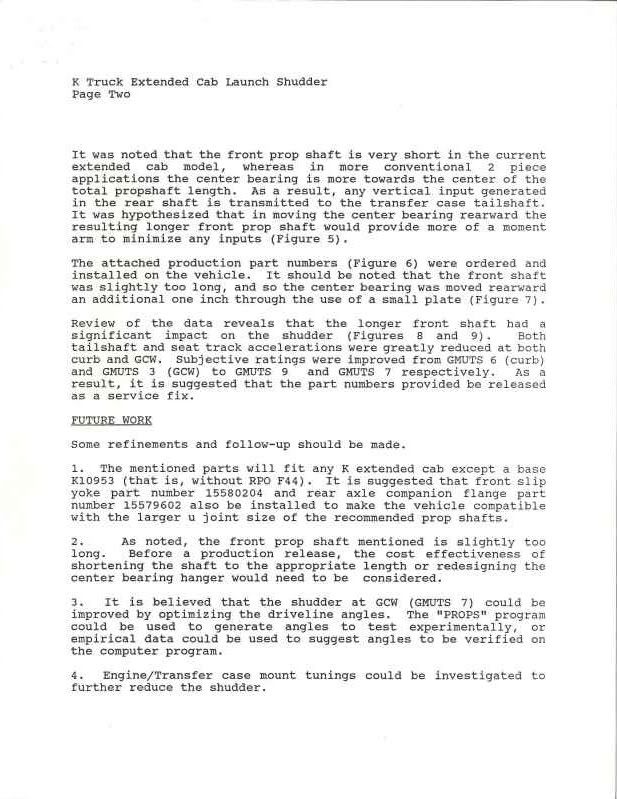 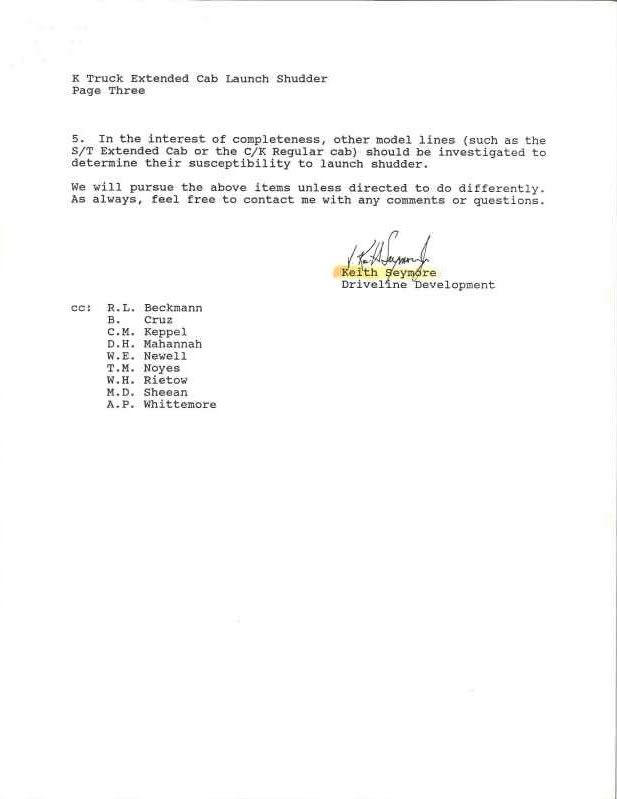 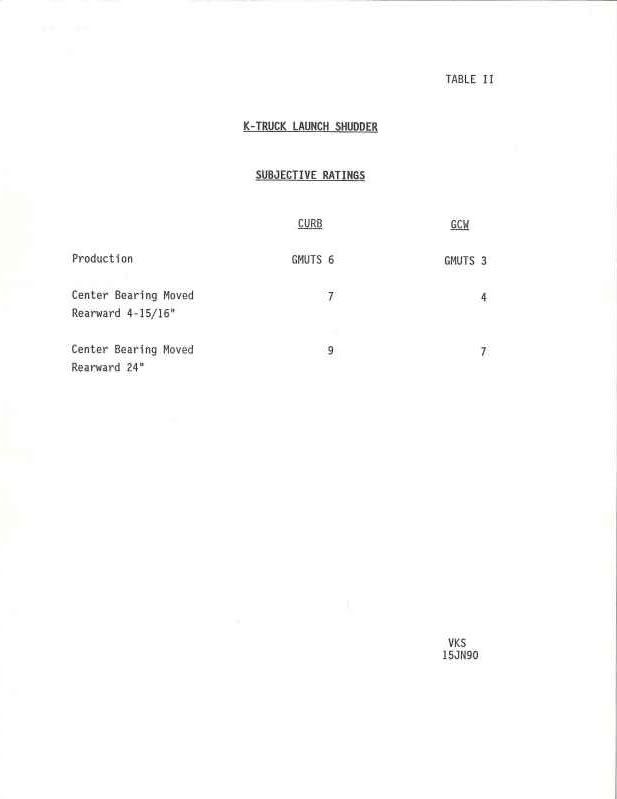 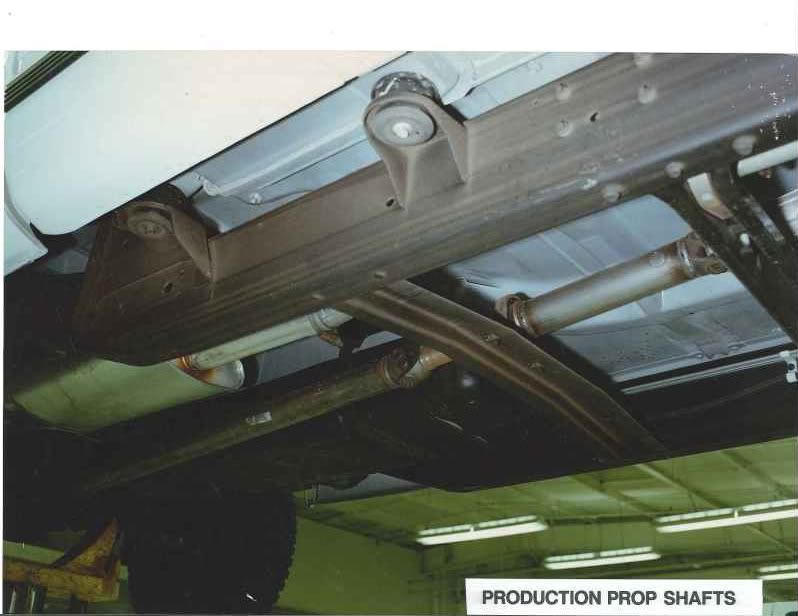 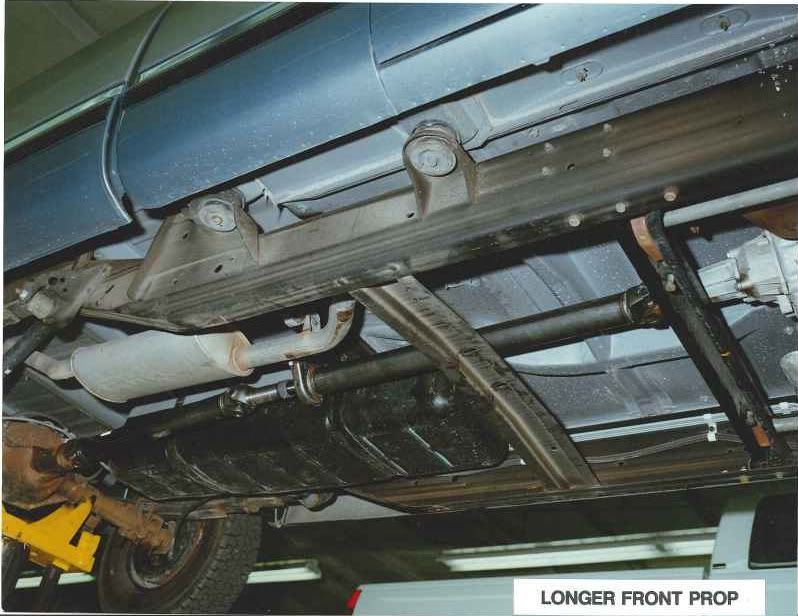 (insert "Back to Topic" emoticon here) K
__________________
Chevrolet Flint Assembly 1979-1986 GM Full Size Truck Engineering 1986 - 2019 Intro from an Old Assembly Guy: http://67-72chevytrucks.com/vboard/s...d.php?t=342926 My Pontiac story: http://forums.maxperformanceinc.com/...d.php?t=560524 Chevelle intro: http://www.superchevy.com/features/s...hevy-chevelle/ Last edited by Keith Seymore; 05-27-2010 at 11:24 AM. |
|
|

|
|
|
#16 | |
|
Registered User
Join Date: Feb 2008
Location: Sidney,b.c.
Posts: 4,425
|
Re: Drive shaft vibration?
Quote:
a couple of notes and 1 was that the frt shaft was to long. 2; in the photos, I notice that the slipyoke at the carrier section is reversed to what they use to be in the earlier applications. so that there is an overhanging centre of balance to the front shaft. earlier applications have that slip yoke reversed so that the ujoint is just off the centre brg. my point is that the fulcrum is at the centre brg and not what looks to be at least 15" back which cpuld cause a vertical whip to the shaft under accelleration. the old laws of physics and leverage. downward thrust of the rear d/shaft under acelleration with the ujoint at the centre brg wouldn't cause any (or shouldn't) any vertical distortion of the frt shaft, however with that extended frt shaft(my view) with that slip yoke with the ujoint to the rear of it(solid ext of the frt shaft and overhanging the rear of the centre brg-creating a fulcrum). upon acelleration the downward thrust of the rear d/shaft can force that ext to flex causing your vertical distortion. is this not a possibility? ron I note that they also went to larger tubing which will also in effect reduce flexion I know that we have slipped away from the orig topic, but still illustrates what changes to d.line can effect Last edited by padresag; 05-27-2010 at 01:00 PM. |
|
|
|

|
|
|
#17 | |
|
Senior Car Nut
 Join Date: Jan 2008
Location: shellman bluff, GA
Posts: 1,411
|
Re: Drive shaft vibration?
Quote:
Keith, thanks for sharing your paper. Steve, have you gone to sleep?
__________________
Larry |
|
|
|

|
|
|
#18 | |
|
Registered User
Join Date: May 2009
Location: Motor City
Posts: 9,245
|
Re: Drive shaft vibration?
Quote:
1) You are correct about the slip joint reversal; we were using some "off the shelf" components in an effort to sell our fix to management, and that's what we ended up with 2) I believe you are correct about the "leverage" of the shaft length and it's acting as a fulcrum, but backwards: that is, if the force is applied vertically to the short shaft there is not as much length to oppose it at the t-case; the longer front shaft has a greater moment arm to resist the input (considering the center bearing as a fulcrum). 3) Driveline "whip", at least in the sense of the ends staying stationary and the middle swinging (like a jump rope) should only be a concern as the shaft approaches it's critical speed. Since this is a very low speed manuever it can be disregarded here. Similarly, the shaft diameter should be moot at these torque levels and the shaft itself can be considered to be "rigid". K
__________________
Chevrolet Flint Assembly 1979-1986 GM Full Size Truck Engineering 1986 - 2019 Intro from an Old Assembly Guy: http://67-72chevytrucks.com/vboard/s...d.php?t=342926 My Pontiac story: http://forums.maxperformanceinc.com/...d.php?t=560524 Chevelle intro: http://www.superchevy.com/features/s...hevy-chevelle/ Last edited by Keith Seymore; 05-27-2010 at 04:01 PM. |
|
|
|

|
|
|
#19 | |
|
Registered User
Join Date: May 2009
Location: Motor City
Posts: 9,245
|
Re: Drive shaft vibration?
Quote:
...The downside is that the roller bearings would not move in the cap, and eventually would brinnel in the cap causing roughness and ultimately failure. Fortunately - that never happens (as a result of this root cause), since the angles are almost never straight statically and, even if they were, they tend to not stay straight when in use dynamically. MHO - K
__________________
Chevrolet Flint Assembly 1979-1986 GM Full Size Truck Engineering 1986 - 2019 Intro from an Old Assembly Guy: http://67-72chevytrucks.com/vboard/s...d.php?t=342926 My Pontiac story: http://forums.maxperformanceinc.com/...d.php?t=560524 Chevelle intro: http://www.superchevy.com/features/s...hevy-chevelle/ |
|
|
|

|
|
|
#20 | |
|
Registered User
Join Date: Feb 2008
Location: Sidney,b.c.
Posts: 4,425
|
Re: Drive shaft vibration?
Quote:
ron |
|
|
|

|
|
|
#21 | |
|
Registered User
Join Date: Feb 2008
Location: Sidney,b.c.
Posts: 4,425
|
Re: Drive shaft vibration?
Quote:
there are a good handful of area which can cause his problem though. most times they are looking for something more complex than what is there. most times if they double check what they did, they will find the problem. wasn't there when they started but was there when they finished; what did they touch have a good one ron |
|
|
|

|
 |
| Bookmarks |
|
|